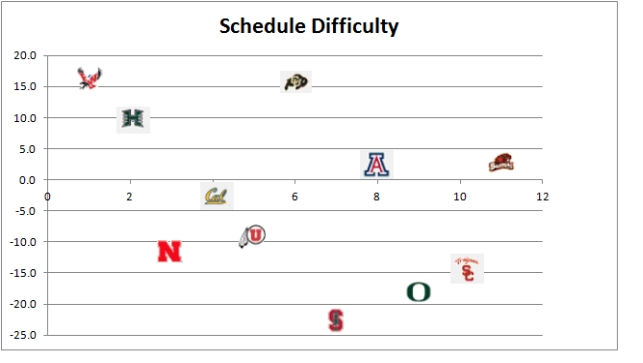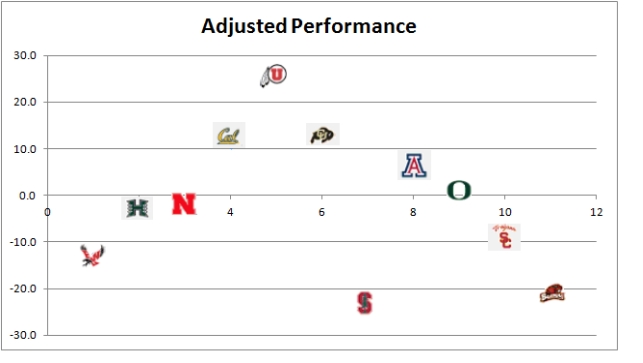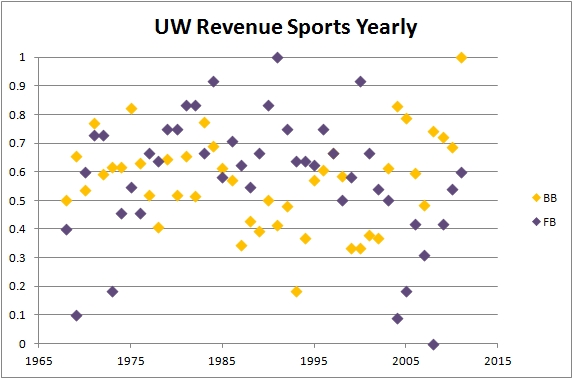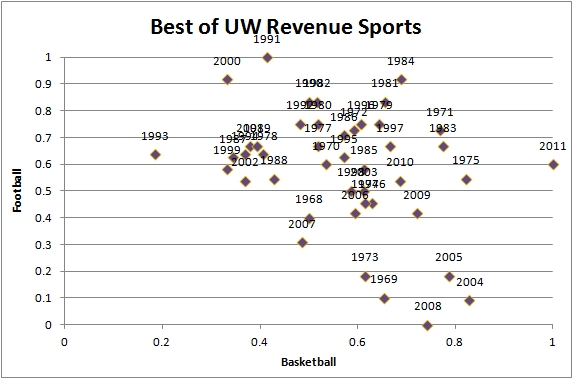Generally, I like to consider myself an open-minded thinker. There are few opinions I hold that I am entirely unwilling to challenge from time to time, especially in the face of persuasive arguments to the contrary. One of these rare exceptions is my position that Lorenzo Romar is an outstanding college basketball coach.
So it was only natural that I took exception to a guest post on the seattlepi.com Undrafted Free Agent blog entitled “Will UW ever win big with Ro-Motion?” by David Ko. I’m not normally in the habit of picking apart every column I disagree with, but A.) this got some media attention from a source I respect and B.) it’s indicative of a general mindset that exists amongst a lot of Husky fans, and I’d like to do whatever I can to stomp it out.
I’d encourage you to go read the post–or at least skim; it’s long–before I rebut it. I won’t reprint it here in its entirety a la Fire Joe Morgan because another of my firmly held beliefs is that it’s wrong to deprive the author of their pageviews. I’ll still be here when you get done.
Good?
There are, I’d say, two general aspects of this argument undercutting Romar:
1. I don’t like the style Romar coaches
2. The Huskies should win more than they do
Let’s take these one at a time.
Yet one disturbing secret lies behind this apparent success at UW: Lorenzo Romar cannot coach basketball. Despite his three-year college playing career under Marv Harshman at UW, his five-year stint in the NBA, and his nearly 20-year coaching career as both an assistant and a head coach, Romar has either never bothered to learn the most basic and fundamental principles of basketball, or knows them but has failed to effectively communicate those principles to his team because he does not place great emphasis on them (the more likely scenario).
Long-time college and NBA coach Larry Brown popularized the phrase “play the right way.” I hate this phrase. It implies that there is one way to win basketball games, and all available evidence suggests this is not the case. There are college coaches that win at fast paces and slow paces, that win with offense and with defense, that win with freshmen and with seniors, that win with big rotations and with thin benches. The common denominator–the fundamental principle of basketball–is outscoring the opposition. There are many ways to get there.
The St. Louis game also highlighted an inaccurate perception about Romar-led Husky teams: that UW is a good defensive team. UW is in fact a very poor defensive team by most fundamental standards. [ … ] And in fact UW ranks 134th in the nation in defensive field goal percentage this year, and in the past five years, UW has finished no higher than 81st (in the ’07-’08 campaign) in the nation in this statistic. Individual effort and enthusiasm should never be confused with sound fundamental team defense.
Ko cites field-goal percentage defense, which is better than points allowed per game but still incomplete, especially because of the very fact he laments–that the Huskies’ focus on putting pressure on the perimeter occasionally sacrifices easy baskets. Honestly, Romar’s defensive philosophy doesn’t quite match mine, either; I prefer a Pat Riley-style focus on cutting off the paint that trades turnovers for lower shooting percentages and fewer trips to the free throw line. Still, there is no argument that Romar’s defense has been generally unsuccessful. Washington ranked ninth in the nation in adjusted defensive efficiency in 2009 and has been in the country’s top 31 three times in the past seven seasons. This year’s defense ranks 136th. The Huskies have unquestionably struggled because of limited size (and especially experience size) in the frontcourt. But one season cannot be taken as a rejection of Romar’s entire defensive style.
From a broader perspective, I think it’s important to note that comparing a coach’s decisions to what you would do is a terrible way to evaluate them. One of my favorite pieces of writing is a Bill James column on the problems of this method. I think everyone on the Internet should be required to read James’ column at least once a year. Ultimately, if you use this measure, you will find that no coach in the world meets your standards, because you are the only person who views things the exact way you do.
This pick-up style of offense consists of fast-break offense for the first 35 minutes of a game, followed by a frustrating five minutes of offense consisting of the following: Gaddy or Wroten checking to see if the ball still has air by pounding the rock for 15-18 seconds at the top of the key, an off the ball screen set by a post for Ross or Wilcox on the baseline (and by “screen” I am being highly complementary as our posts tend to fill space rather than set an actual screen, a trait directly attributable to poor-coaching), a subsequent pass to Ross or Wilcox on the wing, ultimately followed by either (1) a Ross or Wilcox three from the spot where the pass was received, (2) a Ross or Wilcox drive from the wing, or (3) a pass back to either Gaddy or Wroten at the top of the key for a Gaddy or Wroten drive to the hoop. In all circumstances, Romar is on the sidelines pumping his fists imploring his team to move. “Hey coach – but where should we move?”
Again, the numbers speak for themselves. The Huskies were a top-10 offense a year ago, and this season’s ranking (65th) in adjusted offensive efficiency is the team’s worst since Romar’s first season in Seattle. A larger point is that I think the influence of the transition game on overall offensive performance tends to be overstated. There just aren’t that many opportunities for any team to run. Paul Westhead and other novelties aside, every team (including Washington) uses half-court offense on at least about 80 percent of its possessions. No team (including Washington) can rely on transition alone. The Huskies must be doing something right on the half court. (Including maybe, just maybe, running plays every once in a while.) Last year, the inimitable Luke Winn charted the half-court efficiency of the nation’s 10 fastest teams from multi-bid leagues. Washington was tied with Duke for the most points per possession.
Speaking of screens, when is the last time UW successfully ran a pick-and-roll?
Well, I was unable to watch the Seattle U game as closely as I would have liked, but probably then. To return to the Winn well, last January he looked at the five most efficient pick-and-roll scorers in the country. Isaiah Thomas ranked fourth.
This is a concrete example of Romar’s inability to coach basketball, and the numbers bear this out. In games decided by 5 points or less, Romar owns a disturbing 57-65 record, including a 17-26 clip since the 2006-07 season, the year after Roy’s senior season. Good coaches win close games. Romar does not. And so long as Romar does not stress the details, I suspect this trend will continue.
Admittedly, this is a point I must concede. Profane protestations aside, this is a decent sample size. Based on the Huskies .722 record in non-close games over that span and my research on close games in the NBA, Washington should have gone about 25-18 in those games. Romar’s performance is about 2.4 standard deviations below that expectation, which is approaching statistical significance. At the same time, we’re talking about a difference of eight wins over five-plus seasons. The practical significance of the difference is much lower, but if feels painful, which leads into the second aspect of the argument.
The third and final type of Romar-loss is the out-classed and overmatched loss – the loss that reveals UW is not ready to play in the upper echelons of the college basketball elite – as reflected by Duke’s victory over UW in December. [ … ] This loss showed a continued pattern of UW’s failure to win against big-time college basketball teams on the national stage (see UW’s loss to UNC last year, UW’s two losses to Kentucky and Michigan St. in Maui last year, UW’s loss to West Virginia in the Sweet 16 two years ago, UW’s loss Purdue in 2009, UW’s loss to UConn in the Sweet 16 in 2006, and UW’s loss to Louisville in 2005 in the Sweet 16 as a No. 1 seed). In fact, more often than not, UW is outclassed when it plays a team that has a better coach and a better national reputation than UW, despite its roughly equivalent if not higher talent-level.
I know many non-Huskies who perceive an elitism, a feeling of superiority amongst Washington fans. I hate to admit it, but I see the same thing, and I think it’s the source of much of the Romar criticism. You know who else isn’t ready to compete with the upper echelon of college basketball teams? NEARLY EVERYONE IN COLLEGE BASKETBALL. If it was easy, it wouldn’t be an echelon; it would be everybody.
This gets at the fundamental question of realistic expectations. In fairness to the Husky elitists, Washington is a prominent program representing a large research university in a major city, all of which adds up to a large athletic budget (32nd in the country in 2010, and 41st for men’s basketball, per BBstate.com). Surely, expectations should be higher here than in Corvallis. At the same time, those advantages were also available to Romar’s predecessors, who made the NCAA tournament a combined three times in the 17 seasons prior to his arrival. The Romar era alone accounts for more than a third of the program’s total tournament appearances. Maybe he just had the good fortune to come along at a time when Seattle began producing pros at a prodigious rate, but it’s important to remember that Bob Bender was unable to keep talent like Michael Dickerson and Jason Terry at home, as Romar has on a regular basis.
Reasonable people can disagree about the standards for the Huskies’ success. The “never advanced past the Sweet 16” line, by contrast, is inarguably stupid. Are we really to believe that if Mike Jensen hadn’t fouled Marcus Williams or if Louisville hadn’t been massively underseeded in 2005 that Romar would be a better coach? Maybe the argument would just change to “never past the Elite Eight.” Either way, deep NCAA tournament runs are much too random for teams outside the top 10 to earn such heavy weight in the discussion of Romar’s performance.
There’s an interesting context to the timing of this discussion. As Romar and company prepare to face Washington State in Sunday’s first leg of the basketball Apple Cup, Washington’s women teams are preparing to meet on the hardwood as well. The Cougars’ coach, June Daugherty, held the same position at Washington until her contract was allowed to expire at the conclusion of the 2006-07 season. Then-Athletic Director Todd Turner explained that he wanted a “positive buzz” about the team, which had regularly made the NCAA tournament but was not as consistently near the top of the conference as the men’s team under Romar. (Tournament-only analysts will note that Daugherty did lead the Huskies to the 2001 Elite Eight, an obvious sign of her superiority to Romar.)
After striking out on the big-name coaches available, Turner replaced Daugherty with Duke assistant Tia Jackson, who went on to go 45-75 over four long seasons at the helm. By last season, Daugherty had built a Washington State team that had not won more than two conference games in any of the four years prior to her arrival into a program that is just as competitive in the Pac-10 as Washington.
The Husky women are now in good hands under former Xavier coach Kevin McGuff, but it will take years to undo the damage of Turner’s unrealistic expectations. To the handful of Washington fans who want Romar replaced, I urge: Be careful what you wish for.




